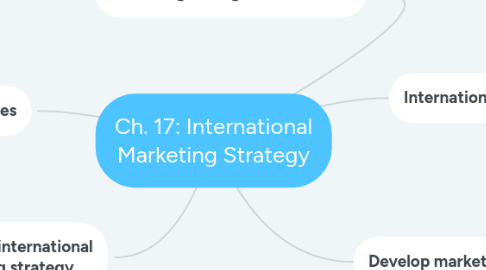
1. Marketing Management Process
1.1. Plan
1.2. Assemble resources
1.3. Implement
1.4. Administer
1.5. Control
1.6. Feedback
1.7. Purpose
2. International Marketing Process
2.1. Planning process
2.1.1. Evaluate the market
2.1.2. Develop a mission statement
2.1.3. Set corporate objectives
2.1.3.1. set marketing objectives
2.1.3.1.1. develop domestic marketing strategy
2.1.3.1.2. develop international marketing strategy
2.1.3.2. other corporate entities
2.2. Assembling of resources
2.2.1. Determine domestic & international resource needs:
2.2.1.1. Equipment
2.2.1.2. Financial
2.2.1.3. Human
2.2.1.4. Materials
2.2.1.5. Physical plant
2.2.2. Identify what is available
2.2.3. Obtain shortages
2.2.4. Coordinate installation
2.3. Implementing process
2.3.1. establish working environment
2.3.1.1. working conditions
2.3.1.2. attitudes
2.3.2. execute plan
2.3.2.1. plan is set in motion
2.3.3. execute tactics
2.3.3.1. to ensure program is properly implemented
2.3.4. assess performance
2.3.4.1. actual vs. projected
2.4. Administer process
2.4.1. provide oversight
2.4.2. motivate
2.4.3. train
2.4.4. build customer relations
2.5. Controlling process
2.5.1. compare assessed performance with target
2.5.2. perform a variance analysis
2.5.3. determine reason(s) for any significant variance
2.5.4. take corrective action
2.5.4.1. if deviation is negative, 2 options:
2.5.4.1.1. if targets are appropriate, will need to adjust:
2.5.4.1.2. if strategy, program & tactics appropriate, will need to adjust the targets
2.5.4.2. if deviation is positive, means performance exceeds expectations
3. Develop marketing strategy
3.1. Initial market entry
3.1.1. influenced by:
3.1.1.1. availability of $ available for investing overseas
3.1.1.2. whether investing overseas is desirable
3.2. Market entry expansion
3.2.1. begin with indirect since least risky & easiest method
3.3. Export strategy
3.3.1. Export or not?
3.3.1.1. decision making process
3.3.1.1.1. Is managements attitude farvorable?
3.3.1.1.2. Does an export stimulus exist?
3.3.1.1.3. Is domestic demand strong?
3.3.1.1.4. Does a need exist that the firm can fulfill?
3.3.1.1.5. Can profits be retained with declining sales?
3.3.1.1.6. Identify markets
3.3.1.1.7. Are foreign opportunities worth the risk?
3.4. Export program
3.4.1. Product
3.4.1.1. examine acceptability of product
3.4.2. Distribution
3.4.2.1. determine if preferred export channel exists in the foreign market
3.4.2.2. if not, consider viability of other channels
3.4.3. Promotion
3.4.3.1. standardize or individualize?
3.4.4. Price
3.4.4.1. sometimes overlooked because of focus on cost
3.4.4.2. active pricing is preferred because it responds to market conditions
4. Ethics in international marketing strategy
4.1. 3 steps to ethical decision making
4.1.1. gather relevant information
4.1.2. determine appropriate moral norms
4.1.3. make ethical judgement regarding decison
4.2. 2 schools of thought
4.2.1. teleology
4.2.1.1. consequences more important than intent
4.2.2. deontology
4.2.2.1. how to behave is more important than the outcome
4.3. 6 ethical theories
4.3.1. egoism
4.3.1.1. consequences for decision maker are main basis to determine if ethical
4.3.2. justice
4.3.2.1. decisions that are fair, equitable, impartial
4.3.3. relativism
4.3.3.1. decision make on case-by-case basis
4.3.4. rights
4.3.4.1. decisions provide those affected with appropriate rights
4.3.5. utilitarian
4.3.5.1. greatest good for greatest number of people
4.3.6. virtue
4.3.6.1. quality & motivation of decision maker matter the most
5. Free Trade Zones
5.1. is a fenced-in area at an air/sea port
5.1.1. not considered to be part of any country
5.1.2. products can be moved in & out without tariffs or duties
